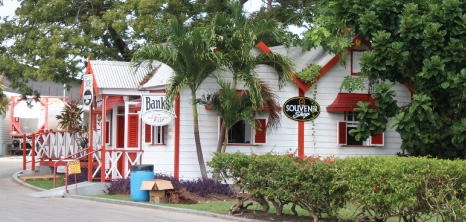|
AttractionsHere's is our top ten list of attractions. Click here for a more extensive list of attractions in Barbados.
Bridgetown, St. MichaelEstablished in 1628, Bridgetown is the capital city of the island of Barbados and a commercial centre and hub of activity, having gained this official recognition after the abolition of slavery in 1838. It is accessible by foot, car or public transportation and the Barbados Port of Authority, in which cruise ships dock, sits just on the outskirts so passengers can make their way into the hustle and bustle of Bridgetown.
Click here for more information on Bridgetown, St. Michael. Oistins, Christ ChurchOn Fridays and Saturday evenings, Oistins comes alive with a completely different ambiance as there is a fish fry par excellence. Scores of vendors cater to their regulars as well as visitors, serving up plates of fish and provisions. Fishcakes, grilled or fried fish, tossed salad, breadfruit and coleslaw only skim the surface of the available fare. In terms of entertainment, there is normally karaoke and a corner with music where the ballroom enthusiasts can 3-step the night away. All this activity takes place around the general environs of the Fish Market, which by this time would have given away to the night time activity.
Click here for more information on Oistins, Christ Church. Morgan Lewis Windmill, St. AndrewLike most parts of the island, this location was an old sugar plantation and in the history annals, it is recorded as the very last mill to operate in Barbados, with the last grinding taking place somewhere between 1945 and 1947. Though in disrepair, the structure of the main building retains some measure of fascination to sight-seers as well as researchers, as it is noted that at that time buildings were held together with very simple concoctions (to include egg whites) since the concept of cement as we know it was non-existence.
Click here for more information on Morgan Lewis Windmill, St. Andrew. Gun Hill Signal Station, St. GeorgeThe Gun Hill Signal Station is strategically perched on a hilltop in the parish of St. George and is one of the six (6) signal stations erected across Barbados after the 1816 Slave Rebellion. This 19th century signal station arguably offers the best views of the entire island of Barbados and contains a captivating collection of military memorabilia. When it was known as Briggs Hill, it was named as one of the four points where guns were to be placed to give alarm in the event of an invasion.
Click here for more information on Gun Hill Signal Station, St. George. St. James Parish Church, St. JamesSt James Parish Church is the oldest church located on the island of Barbados. This church was constructed near the site where the first English settlers landed on the island back on 17th February, 1627. On that day, eighty settlers and ten slaves arrived to take occupation and to settle the island of Barbados in the name of King James I; they called this place Jamestown.
Click here for more information on St James Parish Church, St. James. Hunte's Gardens, St. JosephOn the border of St. Thomas and St. Joseph in Barbados is a tropical paradise inspired by a single man with a background in horticulture is Hunte's Gardens. The home of the Gardens is on an old sugar plantations and is in relative proximity to The Flower Forest and Orchid World and signage and directions are significantly adequate that they can be found without issue.
Click here for more information on Hunte's Gardens, St. Joseph. Animal Flower Cave, St. LucyCenturies ago, back in 1780, two (2) foreign explorers came upon something special, the likes of which have never been found on any other part of the island. The Animal Flower Cave is located at North Point, in the parish of St. Lucy, Barbados and is located underground below the cliff face and is the only accessible sea cove in Barbados. The stairs leading from the cliff down to the cave were built circa 1912 and are safe. In the cave live sea anemones, which have been christened otherwise as "animal flowers". It follows that their existence has influenced the name of this local attraction.
Click here for more information on Animal Flower Cave, St. Lucy. Speightstown, St. PeterOn the north-western side of the island of Barbados, there is a town, a town classified as the second largest town on the island: it is called Speightstown. It was settled in 1630 and named after a gentleman and landowner by the name of William Speight, after whom the town has been named. In its heyday, back in the 17th century, Speightstown was considered a thriving port and was an important link in the island's trading activities. There are certainly things to do in Speightstown. If seeking cultural enrichment is an option, there is an art gallery and a historical museum. In terms of dining options, there are snackettes, fast-food outlets and then other locations, where one can avail of good Bajan food, day in, day out.
Click here for more information on Speightstown, St. Peter. Four Square Rum Distillery & Heritage, St. PhilipThe production of rum and its by-products has contributed to the economic life of Barbados in the past and continues to do so up to this day. There are several refineries on the island which can boast their own production set-up; however the Foursquare Rum Refinery located in St. Philip has the most modern premises and systems. A rum-producing plantation in the 17th century, Foursquare derived its name from the existence of a square-shaped pond in the general area.
Click here for more information on Foursquare Rum Refinery & Heritage, St. Philip. Harrison's Cave, St. ThomasA thing of beauty is a sight to behold. Every country around the globe has at least one natural wonder which it invites everyone to come see, enjoy and appreciate. Harrison's Cave is such a natural gem; a limestone cavern in the depths of the earth in the parish of St. Thomas on the island of Barbados. One of the most sought after sight-seeing spots on the island, it is an underground adventure. The cave is named after Thomas Harrison who owned the majority of land in the area back in the 1700s. This is the same person who established Harrison College, one of the top secondary schools in Barbados, in 1733. The caves basically remained closed to the mind and to the imagination until 1970 or so.
Click here for more information on Harrison's Cave, St. Thomas.
|



